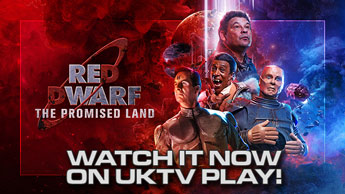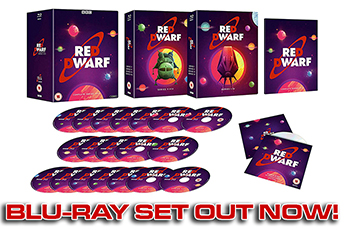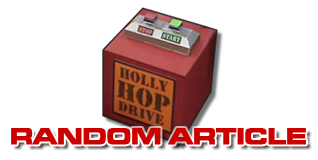 |
Boss of Blowing up Peter Wragg was already a veteran of the effects industry when he was asked to design a little vessel named Red Dwarf. From live TV to big-budget drama, Peter has done it all - ending his time at the BBC as head of the Visual Effects department. Mr Flibble met with Peter to find out why he's going back to the plastic kit bits and glue guns... |

Andrew Ellard
Peter began by saying how nice it was to work with Mr Flibble again. Mr Flibble said, 'Sorry, have we met before?' Andrew chastised him for never remembering the back-room boys, then asked: The BBC effects department work on every kind of show, do you approach each one differently?
You approach it the way the script is. So for dramas, obviously you're going for as much realism as possible; for comedy programmes you're doing it to create comedy, so doing programmes like Some Mothers Do Have 'em and Bottom you create the effects in order to get as much comedy as possible. Whereas with the dramas, like Threads, you are going for REALISM.
So the need for realism is less on a comedy?
I suppose people aren't expecting them to be realistic, so therefore the comedy element is the important bit. But by the same token it can also be more difficult - because a lot of comedy programmes are recorded in front of an audience, and you never want to give the gag away until you actually perform it in front of the audience.
So quite often you'll have to go to greater lengths to make sure that the set-up that you've done is always hidden. Whereas on a drama, it's rehearse-shoot, rehearse-shoot.
LIVE TV must be even more nerve-wracking...
There are times when [it's] 'Right, I've got to get the timing of this absolutely spot-on, because there won't be a second [chance].' There is certainly an adrenaline rush, and there's certainly a great sense of satisfaction when it all works. Then you really do get a buzz and you're on a high, because you've made something work.
Michael Crawford in Some Mothers... didn't want to stop. Because he was doing it in front of a studio audience, he wanted to run right through without stopping - and then if there were any pick-ups to be done, do them at the end. Quite often they'd have an awful lot of effects on it, and so we'd be running from one part of the set to another part to another part - 'right, that's my cue,' press the button, run round to the next bit...
Mr Flibble said he was remembering talking to someone about the explosions from his hex-vision. Might that have been Peter? Andrew asked: As a hands-on model-maker, is it hard to delegate as a head of department?
It is difficult, but it's not too bad if you're there next to it, where you can say, 'Alter that shape,' something like that. Where it does become very difficult is when it ends up going outside somewhere, and you've lost control over what's happening.
It was difficult to combine the two when I was managing the department as well as doing shows like Red Dwarf. Red Dwarf requires full attention - and obviously, managing the department, there were expectancies of me. That I would be available to go to meetings and everything else. So it became very difficult.
How did you get involved with RED DWARF?
I'd worked with Paul Jackson on a number of things - Filthy Rich and Catflap and stuff like that - and Paul said, 'Right, we've got this new series called Red Dwarf, we need model shots of the Red Dwarf space ship - and we want them to look good.'
So I said, 'Okay, fine. There are various ways we can do it.' And in the end we decided that I would do it with motion-control. So we shot Red Dwarf left-to-right, right-to-left, towards, away - all on motion-control. Because Red Dwarf itself was something like 6 foot long, so the thought of flying it on wires was out of the question!

How did the original Red Dwarf ship DESIGN come about?
Rob and Doug had this idea about the ram scoop at the front which sucked meteorites, etc. in; [in line with] the fact that it was a mining vessel. There wasn't a great deal of time in which to make it - initially. (Laughs)
Then the electricians went on strike and the show was postponed!
As it happened there was plenty of time! (Laughs) If it had been made when it was supposed to have been made, then we certainly didn't have much time. Rob and Doug didn't want it to look like a sophisticated space ship, they wanted it to look like something that had been around for donkey's years. A meteorite had imbedded itself in it - so they left it there!
That all worked very well, and when the next series came up, it was Rob and Doug, before they'd written anything, saying, 'What could we actually do?' We met up and we chatted about what was achievable, and in the end I said, 'You write whatever you want to write, and I'll find a way of doing it.'
We talked about snow shots and all that sort of stuff, and it was really nice. They were obviously a bit concerned initially and wanted to see the model shoots - but it became almost impossible, because of the time-frame. But then, after the second series, they said, 'You shoot what you want to shoot. Just tell us where it goes.' It was really nice to be shown that sort of confidence in what I could provide.

Mr Flibble remembered the writers being very accommodating to his creative output. They also bought him a lot of fish. Did you often find IDEAS you'd mentioned making their way into the script?
Oh, absolutely. I mean, it's quite clear that when we talked about the snow scene for Marooned, that's where Marooned came from. I'm sure that they probably had something in their minds at the time anyway, but I think a lot of things developed from having chats. In the later series - VI and VII - it was, 'Have you got any ideas?'
The show got more effects heavy each season - were you expecting it to change that much?
I probably wasn't expecting it to change that much, but I think in hindsight there was an inevitability that the effects would become a bit more predominant. Because it gave them the opportunity to be somewhere else, to have other crafts that the characters could be in. I think it also gave the opportunity for lines like Danny's, 'There's a great big orange swirly thing!' You expect to see it.
Mr Flibble said he remembered Peter now - then realised he was confusing him with someone else. Andrew showed Mr Flibble a picture of himself with Peter, before asking about the use of different kinds of effects on Red Dwarf...
The answer, as far as I'm concerned, is that you chose the right one for the right thing. Don't get caught in a tunnel vision where you think, 'Right, I've got to do everything this way.' You start off and you look at the shots that you need to create, and you say, 'This one would be done better motion-control', 'This one would be best done by [chroma-]keying it in', 'This one we could...'
One of the earlier shots was [Rob and Doug] saying, 'We want them on this planet, around this camp-fire.' And I said, 'What would be nice would be to shoot them live and then I'll do a model. We can put them into the model and then with Paintbox we can blend it all in.'
If you can do things simply, do them simply. I think we had four different scales of Starbug, so you use the scale that works best for the shot you're trying to get. It's being aware of all the different techniques that are available to you. It might well be that what you're saying is, 'Actually, for this shot, we'll do this bit live, we'll do this bit as a model, then CGI this bit into it - and use all the techniques.'

What are your thoughts on the evolution of CGI?
I think it's great! You can do fabulous things with CGI. I just don't feel that anyone should think that that's the only way to do it. There's a danger that, because it's the latest technology, you think, 'I want to be part of that latest technology, therefore I do everything that way.' Where it's appropriate it looks great, but it doesn't have to be [that] everything's done that way.
With Red Dwarf, Starbug isn't the sort of craft that you would believe flew and existed, so therefore I think there is something nice about the fact that people who watch it know that they could actually touch it. It's a tangible object. Whereas I think you also know when it's CGI. You can tell that it's CGI, and therefore you know you can't touch it. Because it only exists in the computer.
Is the BBC reluctant to get into computer effects?
I was certainly very keen that we should get into CGI. The difficulty was, as always, the funding issue. 'Justify why we should get silicon graphics machines in, when if that's what a production wants, they can go to a facilities house.'
Part of the problem was the factions of the way the BBC went - Production was separate to Resources. I believe that we - the Visual Effect department - should have gone more down that road. But there is another area within resources that do a lot of post-production and stuff like that. Not dedicated CGI, mainly post-production and [chroma-]keying.

Mr Flibble said he remembered Peter - that he was the king of the effects department, master of model-makers and emperor of explosions. Andrew thought he was going a bit over the top. What have you got coming up?
At the moment just deciding what I need to do really. It would be very nice to get back to doing what I wanted to do in the first place - and it wasn't managing a department. It would be nice to get back to a more hands-on situation, be part of it again. Get back to thinking about effects rather than worrying about monthly figures.
Mr Flibble enjoyed talking to Peter Wragg, and now that it's over...Mr Flibble's very cross.














